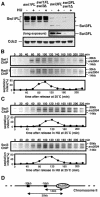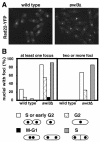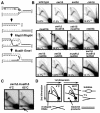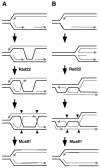Swi1 and Swi3 are components of a replication fork protection complex in fission yeast
- PMID: 15367656
- PMCID: PMC516732
- DOI: 10.1128/MCB.24.19.8342-8355.2004
Swi1 and Swi3 are components of a replication fork protection complex in fission yeast
Abstract
Swi1 is required for programmed pausing of replication forks near the mat1 locus in the fission yeast Schizosaccharomyces pombe. This fork pausing is required to initiate a recombination event that switches mating type. Swi1 is also needed for the replication checkpoint that arrests division in response to fork arrest. How Swi1 accomplishes these tasks is unknown. Here we report that Swi1 copurifies with a 181-amino-acid protein encoded by swi3(+). The Swi1-Swi3 complex is required for survival of fork arrest and for activation of the replication checkpoint kinase Cds1. Association of Swi1 and Swi3 with chromatin during DNA replication correlated with movement of the replication fork. swi1Delta and swi3Delta mutants accumulated Rad22 (Rad52 homolog) DNA repair foci during replication. These foci correlated with the Rad22-dependent appearance of Holliday junction (HJ)-like structures in cells lacking Mus81-Eme1 HJ resolvase. Rhp51 and Rhp54 homologous recombination proteins were not required for viability in swi1Delta or swi3Delta cells, indicating that the HJ-like structures arise from single-strand DNA gaps or rearranged forks instead of broken forks. We propose that Swi1 and Swi3 define a fork protection complex that coordinates leading- and lagging-strand synthesis and stabilizes stalled replication forks.
Figures








Similar articles
-
Hsk1-Dfp1/Him1, the Cdc7-Dbf4 kinase in Schizosaccharomyces pombe, associates with Swi1, a component of the replication fork protection complex.J Biol Chem. 2005 Dec 30;280(52):42536-42. doi: 10.1074/jbc.M510575200. Epub 2005 Oct 31. J Biol Chem. 2005. PMID: 16263721
-
Swi1 prevents replication fork collapse and controls checkpoint kinase Cds1.Mol Cell Biol. 2003 Nov;23(21):7861-74. doi: 10.1128/MCB.23.21.7861-7874.2003. Mol Cell Biol. 2003. PMID: 14560029 Free PMC article.
-
Schizosaccharomyces pombe Swi1, Swi3, and Hsk1 are components of a novel S-phase response pathway to alkylation damage.Mol Cell Biol. 2005 Apr;25(7):2770-84. doi: 10.1128/MCB.25.7.2770-2784.2005. Mol Cell Biol. 2005. PMID: 15767681 Free PMC article.
-
DNA replication: stalling a fork for imprinting and switching.Curr Biol. 2004 Nov 9;14(21):R915-7. doi: 10.1016/j.cub.2004.10.012. Curr Biol. 2004. PMID: 15530381 Review.
-
Exploring the roles of Mus81-Eme1/Mms4 at perturbed replication forks.DNA Repair (Amst). 2007 Jul 1;6(7):1004-17. doi: 10.1016/j.dnarep.2007.02.019. Epub 2007 Apr 3. DNA Repair (Amst). 2007. PMID: 17409028 Review.
Cited by
-
Timeless tunes: replicating happy endings.Cell Cycle. 2012 Aug 15;11(16):2977-8. doi: 10.4161/cc.21530. Epub 2012 Aug 9. Cell Cycle. 2012. PMID: 22874596 Free PMC article.
-
Separation of intra-S checkpoint protein contributions to DNA replication fork protection and genomic stability in normal human fibroblasts.Cell Cycle. 2013 Jan 15;12(2):332-45. doi: 10.4161/cc.23177. Epub 2012 Jan 15. Cell Cycle. 2013. PMID: 23255133 Free PMC article.
-
Genetic controls of DNA damage avoidance in response to acetaldehyde in fission yeast.Cell Cycle. 2017 Jan 2;16(1):45-58. doi: 10.1080/15384101.2016.1237326. Epub 2016 Sep 29. Cell Cycle. 2017. PMID: 27687866 Free PMC article.
-
DNA replication through hard-to-replicate sites, including both highly transcribed RNA Pol II and Pol III genes, requires the S. pombe Pfh1 helicase.Genes Dev. 2012 Mar 15;26(6):581-93. doi: 10.1101/gad.184697.111. Genes Dev. 2012. PMID: 22426534 Free PMC article.
-
Cleavage of stalled forks by fission yeast Mus81/Eme1 in absence of DNA replication checkpoint.Mol Biol Cell. 2008 Feb;19(2):445-56. doi: 10.1091/mbc.e07-07-0728. Epub 2007 Nov 21. Mol Biol Cell. 2008. PMID: 18032583 Free PMC article.
References
-
- Alcasabas, A. A., A. J. Osborn, J. Bachant, F. Hu, P. J. Werler, K. Bousset, K. Furuya, J. F. Diffley, A. M. Carr, and S. J. Elledge. 2001. Mrc1 transduces signals of DNA replication stress to activate Rad53. Nat. Cell Biol. 3:958-965. - PubMed
-
- Alfa, C., P. Fantes, J. Hyams, M. McLeod, and E. Warbrick. 1993. Experiments with fission yeast. Cold Spring Harbor Laboraotry Press, Cold Spring Harbor, N.Y.
-
- Bähler, J., J. Q. Wu, M. S. Longtine, N. G. Shah, A. McKenzie III, A. B. Steever, A. Wach, P. Philippsen, and J. R. Pringle. 1998. Heterologous modules for efficient and versatile PCR-based gene targeting in Schizosaccharomyces pombe. Yeast 14:943-951. - PubMed
-
- Barnes, J. W., S. A. Tischkau, J. A. Barnes, J. W. Mitchell, P. W. Burgoon, J. R. Hickok, and M. U. Gillette. 2003. Requirement of mammalian Timeless for circadian rhythmicity. Science 302:439-442. - PubMed
Publication types
MeSH terms
Substances
Grants and funding
LinkOut - more resources
Full Text Sources
Molecular Biology Databases
Research Materials
